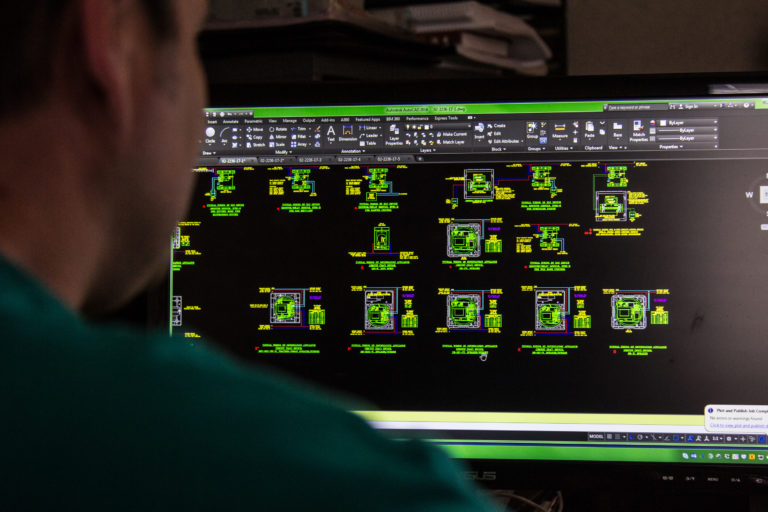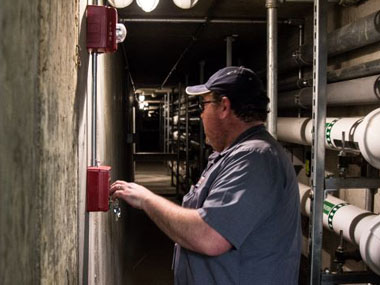DESIGN & INSTALLATION
When designing and installing your next fire alarm project, the Koorsen Engineering Team has the expertise and experience you need. Since 1946, they’ve designed hundreds of fire alarm systems to meet the needs of businesses of all sizes. Contact Koorsen for your next fire alarm design and installation project, whether new construction or an upgrade or expansion.


INSPECTION & TESTING
From design to installation to regular inspections and service, Koorsen Fire & Security is your one-stop-shop for all your fire alarm system needs. We service and inspect all brands of fire alarm systems from a range of high-quality manufacturers. To stay up to date on the evolving technology behind the fire alarm systems, our technicians take part in continuous training and certifications.
SERVICE & MAINTENANCE

Partners & Suppliers
Fire Alarm FAQs
There is probably an issue on the panel. Contact Koorsen, and a fire alarm technician will diagnose and fix the problem leaving you with a working fire alarm that isn’t beeping.
Typically, yes, depending upon occupancy, AHJ, and your insurance company requirements. Very rarely is there a situation when a fire alarm doesn’t require monitoring by a central station.
This is determined by your local AHJ, but it is recommended for proper notification within your building if a fire occurs. A fire sprinkler system is designed to save the property, while a fire alarm is designed to save lives.
Per the NFPA, your fire alarm needs to be inspected by a certified technician once per year. However, some insurance companies require inspections twice a year.
INITIATING DEVICES
Manual Initiating Devices
Pull Station:
Usually wall-mounted, when a person pulls the handle, the fire alarm is activated.
Break Glass Station:
Similar to a pull station but require person to break glass cover before activating the fire alarm.
Automatic Initiating Devices
Smoke Detectors:
A device that senses smoke and sends a signal to the fire alarm panel.
Heat Detectors:
A device that senses abnormally high temps and sends a signal to the fire alarm panel.
Duct Detectors:
A smoke detector device that is installed in HVAC ducts.
Beam Detectors:
A device that detects smoke across large areas using a projected beam of light.
Tamper Switches:
A mechanical and electrical device connected to a sprinkler valve that sends a signal to the fire alarm panel if the valve is partially or fully closed.
Fire Sprinkler Water Flow Switches:
A device that detects movement of water in a fire sprinkler pipe.
CONTROL PANEL
The fire alarm control panel is the brain of the fire protection system that monitors all initiating devices and activates notification devices when there’s a fire so everyone in the building can evacuate safely and the fire department can respond quickly.
NOTIFICATION DEVICES
Strobe:
When the fire alarm system is activated via an initiating device, the strobe, a flashing light, is activated, letting people know to evacuate. Strobes are especially important for those who are hard of hearing or deaf.
Speaker:
In fire alarm systems that use a voice evacuation system, a speaker is used.
Speaker Strobe:
A combination of a speaker and a strobe that is used in a voice evacuation system.
Horn Strobe:
Unlike a speaker strobe, a horn strobe emits a loud alert sound along with the flashing strobe light.
BATTERY BACKUP
In case of a power outage, a battery backup powers the fire alarm system so that it can continue to operate and monitor for fires.
<span data-metadata=""><span data-buffer="">ANNUNCIATOR
In case of a power outage, a battery backup powers the fire alarm system so that it can continue to operate and monitor for fires.
DOOR HOLDERS / CLOSERS
In the event of a fire, a door closer/holder will close the fire doors in a building to limit the spread of the fire and smoke.

Visual Inspection Schedule
- Control Equipment – checked weekly
- Batteries – checked monthly or semi-annually (depending on the type)
- Duct, Heat & Smoke Detectors – inspected semi-annually
- All Equipment – checked annually
Testing schedule
- Control Equipment – tested annually
- Batteries – tested annually
- Initiating Devices – tested annually
- Notification Appliances – tested annually
- Fire Alarm Control Unit Trouble Signals – both audible and visual signals tested annually
- Integrated Mass Notification Systems and Specialized Components – tested annually
